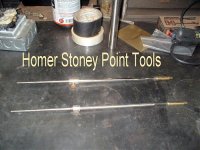J
JeffL
Guest
I made myself an OAL gauge similar to the Hornady. I bought two 12" brass tubes. One is 3/16 and the other is ??? (Old age has got me. I'm at work and I can't remember what size the other one was. Maybe 5/32. It is just small enough to slide nicely inside the 3/16" tube.) I drilled a 3/16" hole in the bottom of the case (through the primer hole). The brass tube fit fairly tight into the case. I first tried putting treads on the tube but couldn't get it to work. I think it was too thin. On this one I put a nylon spacer on the end and use screw thing from a screen door hold down. I don't think one really needs this. If you very slightly dent the outside tube or something, it will make it slide tighter and will hold the position with out the setscrew. Insert the larger tube in the chamber and push on the smaller tube until it hits the lands, remove and measure. On mine I also slit the neck of the case to make it easier to get the bullet in and let it slide. Sometimes the bullet would stay in the barrel. One just needs to push the whole assemble it out with a dowel if it does that. This only cost me about $5.
Here are some pictures.



Here are some pictures.







